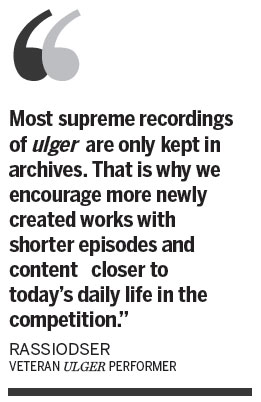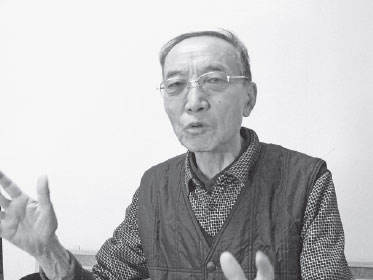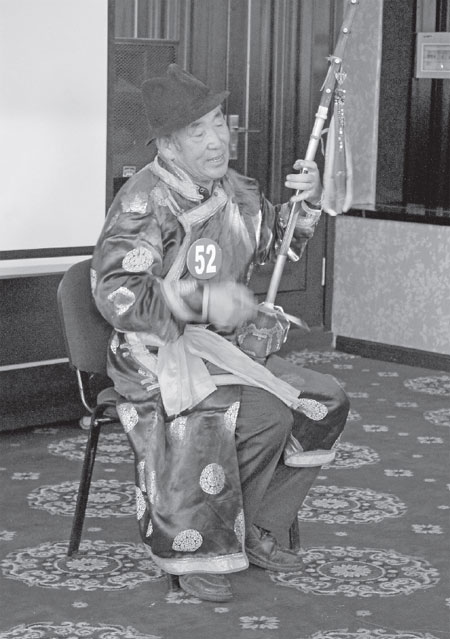Tell a good story
By Wang Kaihao (China Daily)
Updated: 2014-01-15
Tongliao is not only known for its many Mongolian beauties, it is also home to a 700-year-old art of storytelling. Wang Kaihao finds out how the locals are trying to preserve this fading cultural heritage.
The Inner Mongolia autonomous region's eastern city of Tong - liao is famous nationwide for producing many Mongolian beauties of the Horqin tribe throughout history.
But today, in a ballroom, the attraction is something different. The arena is small and simple, a chair, a sihu (a four-string bowed string instrument also known as khuuchir) and a good voice are all that is needed by performers with cadence and rhyme.
Audiences of all ages from the Mongolian ethnic group laugh and cheer from time to time. Even those who do not know an iota of Mongolian language find the shows amusing just by looking at the performers' exaggerated emotions.
Ulger, or Mongolian storytelling, mostly popular among the Horqin tribe in east Inner Mongolia, and nearby northeastern provinces, became one of the first national intangible cultural heritage items in 2006.
It is generally believed to have been formed in the Yuan Dynasty (1271-1368). That era offered many opportunities for the cultures of Mongols and Han to mix, transferring many historical legends of the Han people, like Romance of the Three Kingdoms and Romance of Sui and Tang Dynasties, northwards to the grasslands.
Genghis Khan and other nomadic leaders also contributed stories, according to a veteran ulger performer Rassiodser, who is also a judge of Inner Mongolia's ulger competition held every January. Tongliao has hosted the competition for three years in a row.
"Mongolians cannot resist its everlasting charm," he says proudly, referring to how many people keep squeezing into the ball room. "It gathers the essence of our ethnic group's music and literature."
Though this 73-year-old man regrets he is no longer as energetic as he once was, he always has a transistor radio at hand to search for his beloved melody on the airwaves.
Ulger episodes had no written scripts until the late Qing Dynasty (1644-1911) when they borrowed characteristics from Han novels and thus became easier to be circulated. There are nearly 80 traditional scores accompanying the storytelling. Choor, a two-string musical instrument was long used in ulger, but it was gradually replaced by sihu in the early 20th century to increase the expression patterns.
Born in Tongliao's Jarud Banner, a county-level administrative region nicknamed "hometown of ulger", his uncle Pajie (1902-62) was unanimously considered to be the top ulger artist in the 20th century. Rassiodser attributes the reason he fell in love with storytelling to its high popularity in his hometown, but he also says family reputation gives him much impetus.
Rassiodser cites the ulger episode adapted from the famous 12th-century epic circle The Epic of King Gesar, which takes 90 hours to finish chanting. He is among the few people who are still able to complete this storytelling marathon, and thus was titled province-level inheritor of intangible cultural heritage in 2010.
"But, it is hard to include a complete chapter in the repertoire of today's TV galas, which last only for a few hours." He opines the lengthy episodes are an obstacle stopping the arts from spreading widely today.
"We thus lose many chances to make it better known to the public. Most supreme recordings of ulger are only kept in archives. That is why we encourage more newly created works with shorter episodes and content closer to today's daily life in the competition."
In Jarud Banner, local people also struggle to better protect their cultural pride.
Wang Cheng, deputy chief of the banner's cultural relic protection office, sighs when recalling the days collecting ulger-relevant antiques.
"People took the items for granted and did not recognize how valuable they were," he says, introducing 150 relevant pieces exhibited in a 100-odd-square-meter mall next to his office, also the banner's ulger museum. "When we found manuscripts and old time's choor and sihu pieces, many had been damaged in water and fallen into disrepair.

"We need a bigger room and better conditions to save more items, but it's hard to apply for a construction permit," Wang smiles with embarrassment, pointing to a half-finished blueprint for a public museum. "Building a museum in our less than wealthy place will easily be misunderstood by the public as squandering money."
Zhao Hongwei, head of the administrative office of the Jarud TV station, is equally concerned.
"After TV became popular in pasturing areas in recent years, there are many more things other than sheep, cows and yogurt in young minds," says Zhao, adding the TV station has opened a channel only broadcasting ulger and several other relevant local traditional storytelling genres.
They organize a 10-person volunteer arts troupe to hold daily ulger shows in the banner's cultural center. A local Mongolian elementary school has also opened a class to train children to be good storytellers.
"We cannot stop young people from loving modern entertainment, but we can keep doing something small to prolong the life of ulger," Zhao sighs.
Things look promising with the Inner Mongolia University based in the autonomous region's Hohhot launching a five-year project in November, to categorize and study scattered ancient ulger scores and scripts.
According to the program leader Quanfu, also a Mongolian studies professor from that university, his 20-strong team will select 300 of the most important pieces of ulger scripts for in-depth study, among which half are classical episodes that circulated since ancient times. The group also plans to compile biographies for 300 ulger performers and select 30 of the most prestigious active ones to record as part of an oral history project. The professor admits the lack of information is a major issue for his study, so his priority is to establish a solid database.
"Ulger is a crucial link between heroic epic in Mongols' early history and their narrative folk songs in later times," Quanfu says. "People cannot clearly understand the continuity of Mongolian literature and folklore without a solid study on ulger.
"It is also a symbolic icon for cultural communication between Han and Mongolian people, which not only needs closely related academic majors, including ethnomusicology, linguistics and anthropology, but also media studies. This program will create a model for our future interdisciplinary studies."
Contact the writer at wangkaihao@chinadaily.com.cn.

|
A contestant performs at the 2014 Inner Mongolia Ulger Competition in Tongliao, the Inner Mongolia autonomous region. Photos by Wang Kaihao / China Daily |

High-speed train debuts in Inner Mongolia
A bullet train departed Hohhot East Railway Station for Ulanqab marking the start of high-speed rail services using Inner Mongolia’s first newly-laid high-speed railway on Aug 3.

